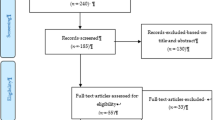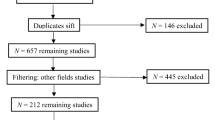Abstract
The misuse of prescription drugs by teens in the United States is a growing public health problem. This article provides a systematic synthesis of multiple strands of literature to recommend effective prevention methods. Using a social-ecological framework, we review the scope of the problem of prescription drug use among teens. Then, we analyze the multiple factors that may influence teen knowledge and attitudes toward prescription drugs and discuss the important challenges related to the construction of effective prevention programs. Finally, we provide recommendations for practice that attempt to overcome these challenges.

Similar content being viewed by others
References
Ajzen, I. (1991). The theory of planned behavior. Organizational Behavior and Human Decision Processes, 50, 179–211. doi:10.1016/0749-5978(91)90020-T.
Boyd, C. J., McCabe, S. E., Cranford, J. A., & Young, A. (2006a). Adolescents’ motivations to abuse prescription medications. Pediatrics, 118, 2472–2480. doi:10.1542/peds.2006-1644.
Boyd, C. J., McCabe, S. E., & Teter, C. J. (2006b). Medical and nonmedical use of prescription pain medication by youth in a Detroit-area public school district. Drug and Alcohol Dependence, 81, 37–45. doi:10.1016/j.drugalcdep.2005.05.017.
Bronfenbrenner, U. (1979). The ecology of human development. Cambridge, MA: Harvard University Press.
Brownfield, E. D., Bernhardt, J. M., Phan, J. L., Williams, M. V., & Parker, R. M. (2004). Direct-to-consumer drug advertisements on network television: An exploration of quantity, frequency, and placement. Journal of Health Communication, 9, 491–497. doi:10.1080/10810730490523115.
Compton, W. M., & Volkow, N. D. (2006). Abuse of prescription drugs and the risk of addiction. Drug and Alcohol Dependence, 81, 103–107. doi:10.1016/j.drugalcdep.2005.05.009.
Daniel, K. L., Honein, M. A., & Moore, C. A. (2003). Sharing prescription medication among teenage girls: Potential danger to unplanned/undiagnosed pregnancies. Pediatrics, 111, 1167–1170.
Drug Abuse Warning Network. (2007). National estimates of drug-related emergency department visits. DAWN Series D-29. DHHS Publication No. (SMA) 07-4256: Rockville, MD: U. S. Department of Health and Human Services.
Edwards, J. (2007, April 30). Prescription drugs. Ad Week. Retrieved October 9, 2008 from http://www.adweek.com/aw/esearch/article_display.jsp?vnu_content_id=1003577966.
Ellickson, P. L., McCaffrey, D. F., Ghosh-Dastidar, B., & Longshore, D. L. (2003). New inroads in preventing adolescent drug use: Results from a large-scale trial of Project ALERT in middle schools. American Journal of Public Health, 93, 1830–1839.
Everett, M. W., & Palmgreen, P. (1995). Influences of sensation seeking, message sensation value, and program context on effectiveness of anticocaine public service announcements. Health Communication, 7, 225–248. doi:10.1207/s15327027hc0703_3.
Fishbein, M., & Middlestadt, S. E. (1987). Using the theory of reasoned action to develop educational interventions: Applications to illicit drug use. Health Education Research, 2, 361–371. doi:10.1093/her/2.4.361.
Friedman, R. A. (2006). The changing face of teenage drug abuse: The trend toward prescription drugs. New England Journal of Medicine, 354, 1448–1450. doi:10.1056/NEJMp068010.
Frosch, D. L., Kruger, P. M., Hornik, R. C., Cronholm, P. F., & Barg, F. K. (2007). Creating demand for prescription drugs: A content analysis of television direct-to-consumer advertising. Annals of Family Medicine, 5, 6–13. doi:10.1370/afm.611.
Herr-Zaya, K., Botticelli, M., Keel, S., Giovannetti, M., Jimenez, M., Mandlebaum, J., et al. (2007, May). Using social marketing to prevent Oxycontin use among youth. Poster presented at the annual meeting of the Society for Prevention Research, Washington, DC.
Holtz, K. D., & Twombly, E. C. (2007). A preliminary evaluation of the effects of a science education curriculum on changes in knowledge of drugs in youth. Journal of Drug Education, 37, 317–333. doi:10.2190/DE.37.3.f.
Johnston, L. D., O’Malley, P. M., Bachman, J. G., & Schulenberg, J. E. (2006). Monitoring the Future national results on adolescent drug use: Overview of key findings, 2005. Ann Arbor, MI: University of Michigan News and Information Services. Retrieved May 12, 2007 from http://www.monitoringthefuture.org.
Kuehn, B. M. (2007a). Many teens abusing medications. JAMA, 297, 578–580. doi:10.1001/jama.297.6.578.
Kuehn, B. M. (2007b). Opioid prescriptions soar: Increase in legitimate use as well as abuse. JAMA, 297, 249–251. doi:10.1001/jama.297.3.249.
Kumpfer, K. L., & Turner, C. W. (1990). The social ecology model of adolescent substance abuse: Implications for prevention. International Journal of Addiction, 25(S4), 435–463.
McCabe, S. E., & Boyd, C. J. (2005). Sources of prescription drugs for illicit use. Addictive Behaviors, 30, 1342–1350. doi:10.1016/j.addbeh.2005.01.012.
McCabe, S. E., Boyd, C. J., & Young, A. (2007a). Medical and non-medical use of prescription drugs among secondary school students. Journal of Adolescent Health, 40, 76–83. doi:10.1016/j.jadohealth.2006.07.016.
McCabe, S. E., Cranford, J. A., Boyd, C. J., & Teter, C. J. (2007b). Motives, diversion, and routes of administration associated with nonmedical use of prescription opioids. Addictive Behaviors, 32, 562–575. doi:10.1016/j.addbeh.2006.05.022.
McCabe, S. E., Teter, C. J., & Boyd, C. J. (2004). The use, misuse, and diversion of prescription stimulants among middle and high school students. Substance Use and Misuse, 39, 1095–1116. doi:10.1081/JA-120038031.
Morse, L., Wilbur, K., Ballard, K. (2004, February). Unintended consequences: Implications for health and physical education. Paper presented at the No Child Left Behind Forum, Reston, VA. Retrieved October 24, 2006, from http://www.aahperd.org/aahperd/template.cfm?template=nclb.html.
National Center on Addiction and Substance Abuse. (2002). National Survey of American Attitudes on Substance Abuse VII: Teens, Parents and Siblings. New York: Author. Retrieved June 11, 2007 from http://www.casacolumbia.org/supportcasa/item.asp?cID=12&PID=129.
National Center on Addiction and Substance Abuse. (2005). Under the counter: Diversion and abuse of prescription medication in the U.S. New York: Author. Retrieved May 28, 2007 from http://www.casacolumbia.org/absolutenm/articlefiles/380-under_the_counter_-_diversion.pdf.
National Center on Addiction and Substance Abuse. (2007). “You’ve Got Drugs!” IV: Prescription drug pushers on the Internet. New York: Author. Retrieved May 28, 2007 from http://www.casacolumbia.org/absolutenm/articlefiles/380-YGD4 percent20Report.pdf.
National Education Association. (2004). No subject left behind? Think again. NEA Today, 23(3), 26–27.
National Institute on Drug Abuse. (2003). Preventing drug use among children and adolescents: A research-based guide for parents, educators, and community leaders (2 nd ed.). Retrieved October 10, 2008 from http://www.drugabuse.gov/pdf/prevention/RedBook.pdf.
National Institute on Drug Abuse. (2005). NIDA research reports: Prescription Drugs abuse and addiction. Retrieved June 11, 2007 from http://www.drugabuse.gov/ResearchReports/Prescription/Prescription.html.
Orwin, R. (2006). Evaluation of the National Youth Anti-Drug Media Campaign: 2004 report of findings. Rockville, MD: Westat.
Partnership Attitude Tracking Study. (2006). Teens in grades 7 through 12, 2005. Retrieved March 31, 2007 from http://www.drugfree.org/files/full_teen_report.
Partnership for a Drug-Free America. (2005). Generation Rx: National study reveals new category of substance abuse emerging: Teens abusing Rx and OTC medications intentionally to get high. Retrieved March 31, 2007 from www.drugfree.org.
Paulozzi, L. J. (2006). Opioid analgesic involvement in drug abuse deaths in American metropolitan areas. American Journal of Public Health, 96, 1755–1757. doi:10.2105/AJPH.2005.071647.
Prescription drugs: What you need to know .(2007, March). Seventeen.
Randolph, W., & Viswanath, K. (2004). Lessons learned from public health mass media campaigns: Marketing health in a crowded media world. Annual Review of Public Health, 25, 419–437. doi:10.1146/annurev.publhealth.25.101802.123046.
Simoni-Wastila, L., Ritter, G., & Strickler, G. (2004). Gender and other factors associated with the nonmedical use of abusable prescription drugs. Substance Use and Misuse, 39, 1–23. doi:10.1081/JA-120027764.
Spoth, R., Clair, S., Shin, C., & Redmond, C. (2006). Long-term effects of universal preventive interventions on methamphetamine use among adolescents. Archives of Pediatrics and Adolescent Medicine, 160, 876–882. doi:10.1001/archpedi.160.9.876.
Substance Abuse and Mental Health Services Administration. (2004). Misuse of prescription drugs, 2003. Retrieved March 31, 2007 from http://www.oas.samhsa.gov/prescription/toc.htm.
Substance Abuse and Mental Health Services Administration. (2006a). Misuse of prescription drugs, 2005. Retrieved March 31, 2007 from http://www.oas.samhsa.gov/prescription/toc.htm.
Substance Use and Mental Health Services Administration. (2006b). Substance abuse treatment admissions by primary substance of abuse according to sex, age group, race and ethnicity, 2004. Retrieved May 28, 2007 from http://www.dasis.samhsa.gov/webt/quicklink/US04.htm.
Sussman, S., Pentz, M. A., Spruijt-Metz, D., & Miller, T. (2006). Misuse of “study drugs:” Prevalence, consequences, and implications for policy. Substance abuse treatment, prevention, and policy, 1(15), 1–7.
Sung, H., Richter, L., Vaughan, R., Johnson, P. B., & Thom, B. (2005). Nonmedical use of prescription opioids among teenagers in the United States: Trends and correlates. Journal of Adolescent Health, 37, 44–51. doi:10.1016/j.jadohealth.2005.02.013.
Teter, C. J., McCabe, S. E., Cranford, J. A., Boyd, C. J., & Guthrie, S. K. (2005). Prevalence and motives for illicit use of prescription stimulants in an undergraduate student sample. Journal of American College Health, 53, 253–262. doi:10.3200/JACH.53.6.253-262.
Zacny, J., Bigelow, G., Compton, P., Foley, K., Iguchi, M., & Sunnerud, C. (2003). College on Problems of Drug Dependence taskforce on prescription opiod non-medical use and abuse: Position statement. Drug and Alcohol Dependence, 69, 215–232. doi:10.1016/S0376-8716(03)00003-6.
Author information
Authors and Affiliations
Corresponding author
Rights and permissions
About this article
Cite this article
Twombly, E.C., Holtz, K.D. Teens and the Misuse of Prescription Drugs: Evidence-Based Recommendations to Curb a Growing Societal Problem. J Primary Prevent 29, 503–516 (2008). https://doi.org/10.1007/s10935-008-0157-5
Received:
Accepted:
Published:
Issue Date:
DOI: https://doi.org/10.1007/s10935-008-0157-5




